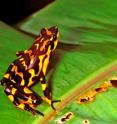ASU researchers urge alternative identification methods for threatened species
In a time of global climate change and rapidly disappearing habitat critical to the survival of countless endangered species, there is a heightened sense of urgency to confirm the return of animals thought to be extinct, or to confirm the presence of newly discovered species. Field biologists traditionally collect specimens to distinguish the animals -- or to confirm that they do indeed exist in the wild. Researchers at Arizona State University and Plymouth University in the United Kingdom want to change the way biologists think about the "gold standard" of collecting a "voucher" specimen for species identification. They suggest that current specimen collection practices may actually pose a risk to vulnerable animal populations already on the brink of extinction.
"We are drawing attention to this issue as an important question bearing on the ethical responsibilities of field biologists. It concerns not only an increased extinction threat to re-discovered species, but also the collection of specimens from small populations more generally," said Ben Minteer, an environmental ethicist and conservation scholar in ASU's School of Life Sciences.
"Because these populations are very small and often isolated, they are incredibly sensitive to over-collecting," added Minteer, also the Arizona Zoological Society Chair at ASU. "Combine the understandable impulse to confirm something really important -- such as that a species is not, in fact extinct -- with the sensitivity of a population to collection and you've got a potentially significant conservation issue."
The researchers raise the issue in the April 18 issue of the journal Science. In the article, Minteer and his colleagues cite examples of the decline or loss of a range of animal species due to the impact of field collections by both professional scientists and amateur naturalists. There are cases of now-extinct birds, as well as the loss and rediscovery of amphibians in Costa Rica.
Changing the "gold standard"
The researchers suggest using a combination of modern, non-lethal techniques to confirm a species' existence including high-resolution photography and audio recordings of sounds or mating calls. Also, using DNA sampling by taking swabs of the mouth or skin offer molecular techniques that could identify an animal without taking a specimen from the field.
The authors say using modern technologies can be just as effective in identifying an organism and will also avoid increasing the extinction risk for small populations.
"The thrill of rediscovering a species must be one of the most exciting events in a biologist's life, however it is easy to forget it comes with significant responsibilities. What impact are we causing to the species even in this first encounter? The technology is there to gather crucial evidence to substantiate our finding without harming the animals. There is no need to collect by default," said Robert Puschendorf, a conservation biologist with the School of Biological Sciences, at Plymouth University. Puschendorf focuses his work on the impacts of disease and climate change on wildlife.
Biology and ethics: balancing ecological impact against value of research
The discussion about replacing non-lethal identification techniques with less-invasive ones is part of a more complex issue. Weighing the benefits of improved scientific understanding of threatened species for conservation, against the research impacts on endangered animals is complicated.
"Studying small populations is a special challenge, especially in cases such as amphibians where species are declining globally, at times to extinction," said James P. Collins, an evolutionary ecologist and Virginia M. Ullman Professor of Natural History and the Environment in ASU's School of Life Sciences.
"Our goal is to highlight this challenge while offering options for documenting exciting, interesting and important discoveries. We are emphasizing the need for investigators to reflect on the wider ethical and social implications of their work before or as they conduct the research and not just after the fact," Collins added.
The researchers are calling for this change in hopes of minimizing the impact scientists have on endangered animals, and they are asking biologists around the world to follow suit.
"The time to change is now," said Minteer. "While we use amphibians as an example in this article, the negative effects of collecting samples from endangered animal populations is a concern that applies across taxa and around the world. The argument that 'this is how we've always done it', is not good enough. Especially in the case of rediscovered species, avoiding 're-extinction' should be the primary ethical constraint of any scientific effort to verify a species' welcome return from the dead."
Source: Arizona State University
Articles on the same topic
- Call for alternative identification methods for endangered speciesThu, 17 Apr 2014, 20:44:15 UTC
Other sources
- Alternative identification methods for threatened species urgedfrom Science DailyThu, 17 Apr 2014, 20:40:27 UTC
- On the Brink of Extinction: ASU Researchers Urge Alternative Identification Methods for Threatened Speciesfrom Newswise - ScinewsThu, 17 Apr 2014, 18:40:41 UTC
- Call for alternative identification methods for endangered speciesfrom PhysorgThu, 17 Apr 2014, 18:12:28 UTC
